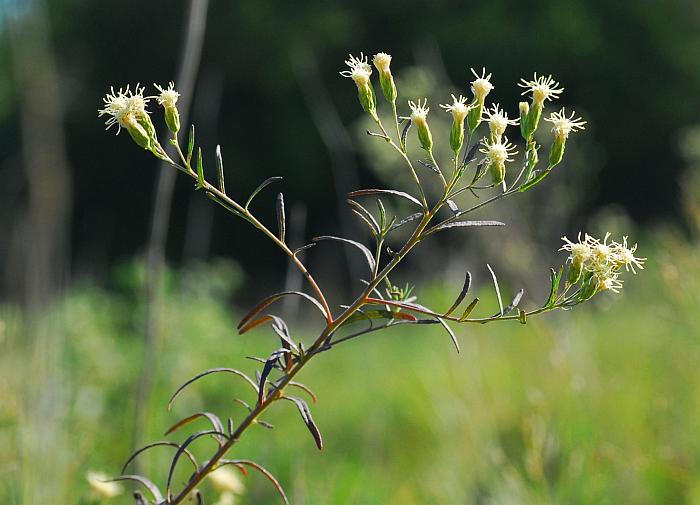Brickellia eupatorioides (L.) Shinners
False Boneset

Native
CC = Amb
CW = 5
MOC = 73
© SRTurner
Brickellia eupatorioides (L.) ShinnersFalse Boneset | |
 |
Native CC = Amb CW = 5 MOC = 73 |
© SRTurner |
|
Family - Asteraceae/Eupatorieae Habit - Perennial forb, often with thickened roots. Stems - Ascending to erect, single or multiple, to 1.2 m, densely and finely hairy, occasionally nearly glabrous.
Leaves - Alternate, simple, sessile or short-petiolate, numerous, closely spaced and sometime appearing almost whorled. Blades to 10 cm, linear or lanceolate or narrowly elliptic, short-tapered at the base, tapered to a sharply pointed tip, the margins entire or irregularly few-toothed, the upper surface somewhat roughened or glabrous, the undersurface sparsely to moderately and finely hairy, sometimes only along the veins, both surfaces moderately to densely glandular.
Inflorescences - Small panicles or stalked clusters of heads at the branch tips, the heads usually erect or ascending
Heads - Discoid. Involucre 7-15 mm long, cylindrical or narrowly cup-shaped. Bracts numerous, in several overlapping, unequal series, linear, glandular, glabrous or finely hairy.
Ray flowers - Absent. Disk flowers - 3-35 per head. Corollas 4-6 mm long, cream colored or pale yellow. Styles exserted at anthesis. Pappus of 20-25 bristles, plumose.
Fruits - Achenes, 3-5 mm, linear or nearly so in profile, 10-ribbed, minutely hairy, dark brown.
Flowering - July - October. Habitat - Upland prairies, sand prairies, loess hill prairies, glades, savannas, forest openings, ledges and tops of bluffs, pastures, roadsides. Origin - Native to the U.S. Lookalikes - Eupatorium altissimum, other species in the Eupatorium genus. Other info. - This species is found throughout most of Missouri, and throughout most of the U.S. except for a few far western and northeastern states. It can be confused with a somewhat more common close relative, Eupatorium altissimum, but the latter plant usually has wider, opposite leaves, denser inflorescences, and disk corollas which are white. The plant is quite variable and, as always, reliable determination is aided by experience. Steyermark and Yatskievych both recognized three varieties (var. corymbulosa, var. eupatorioides, and var. texana) based upon subtle aspects of the involucral bracts. The three are all fairly common in Missouri, are lacking in any obvious regional preferences, and can be difficult to distinguish. Photographs taken in Emminence, MO., 9-28-03, and at the Mountain Longleaf National Wildlife refuge, AL., 10-2-05 (DETenaglia); also at St. Joe State Park, St. Francois County, MO, 9-12-2012 and 9-2-2016; Cuivre River State Park, Lincoln County, MO, 8-15-2014; Onondaga Cave State Park, Crawford County, MO, 9-11-2017, and Salt Lick Point, near Valmeyer, Monroe County, IL, 9-20-2021 (SRTurner). |